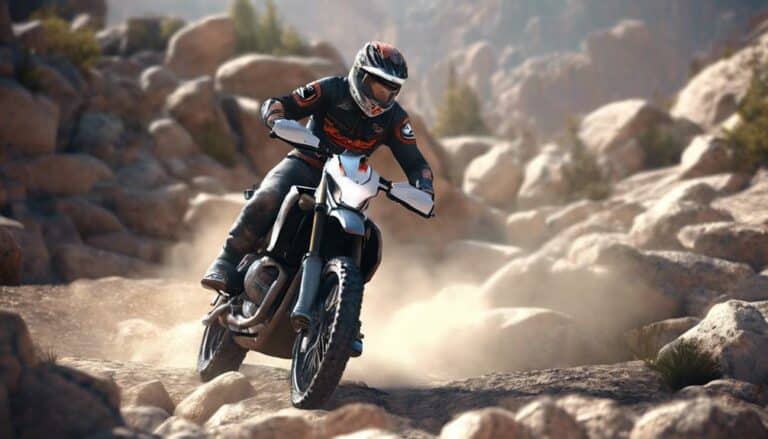When tackling rugged terrain, imagine traversing a rocky mountain trail with your body weight too far back on the motorcycle. The consequences of incorrect body positioning go beyond just discomfort; they directly impact your ability to handle the challenging terrain ahead.
As you push through uneven surfaces and steep inclines, the way you position yourself on the bike can either make or break your success in conquering the rugged landscape.
Stay tuned to uncover the intricate relationship between body alignment and your effectiveness in tackling rough terrains head-on.
Key Takeaways
- Incorrect body positioning reduces stability and control on rugged terrain.
- Poor posture increases the risk of accidents and limits impact absorption.
- Improper alignment hampers maneuverability and obstacle negotiation.
- Bad body placement compromises steering efficiency and shock absorption.
Impact of Incorrect Body Positioning on Stability
How does incorrect body positioning affect your stability while riding on rugged terrain?
Good body position is essential when tackling challenging landscapes. Your riding position plays a key role in maintaining stability and control over your bike. When riding downhill or on rough terrain, make sure your body weight is balanced and your legs are properly positioned. By keeping your weight centered and slightly back, you improve traction on the front wheel, enhancing your ability to steer and navigate obstacles effectively.
Your upper body should be relaxed yet engaged, ready to absorb impacts and adjust to the terrain. Incorrect body positioning can lead to instability, making it harder to react to sudden changes in the landscape. By maintaining a good riding position, you can better handle the challenges of rugged terrain, increasing your overall control and confidence.
Effects of Poor Posture on Control
Poor posture hampers your ability to maintain control over your motorcycle when maneuvering rough terrain. Incorrect body positioning can have significant consequences on your control, making it harder to navigate challenging landscapes effectively.
Here are some key effects of poor posture on control:
- Disrupted Weight Distribution: Improper body positioning can lead to a shift in weight distribution, causing instability and difficulty in maintaining balance.
- Reduced Stability: Riders with poor posture may struggle to keep the motorcycle stable on rugged terrain, increasing the risk of accidents.
- Limited Ability to Absorb Impacts: Inadequate body posture can hinder your capacity to absorb impacts from bumps and obstacles, affecting your control over the bike.
Maintaining proper body positioning is vital for enhancing control, stability, and balance while riding on rough terrain. By correcting your posture, you can improve your ability to respond effectively to challenging terrain features, ensuring a safer and more controlled riding experience.
Limitations of Improper Body Alignment
Improper body alignment greatly affects a rider's stability and control when traversing rough terrain. When riding a mountain bike, being too far forward or leaning back excessively can disrupt your balance, making it challenging to maintain control over the bike.
Proper body position is essential for negotiating obstacles and absorbing impacts effectively. Failure to align your body correctly can lead to poor weight distribution, compromising traction and handling on uneven ground. This improper alignment not only hampers your ability to maneuver through rugged terrain but also increases the likelihood of accidents.
Consequences of Incorrect Positioning on Maneuvering
Incorrect positioning while riding can greatly impact your maneuvering abilities, affecting your balance, control, and responsiveness on challenging terrain. When your body position isn't ideal, several consequences can arise:
- Poor Weight Distribution: Incorrect body positioning can lead to improper weight distribution between the front and back of the bike, making it harder to maintain stability and control while riding on rugged terrain.
- Reduced Steering Precision: Improper body alignment can hinder your ability to steer effectively, decreasing your precision when traversing obstacles and tight corners.
- Limited Adaptability to Terrain: Inadequate body positioning makes it challenging to adjust to changing terrain conditions, reducing your overall maneuverability and confidence when tackling diverse landscapes.
Ensuring proper body position while riding is essential for enhancing your ability to maneuver through challenging terrain with confidence and control. By maintaining the correct alignment, you can optimize your weight distribution, improve steering precision, and adapt more effectively to the demands of the terrain, ultimately enhancing your riding experience.
Implications of Bad Body Placement on Performance
When your body placement isn't best, it can greatly impact your performance on rough terrain, affecting control and stability. Proper body positioning is key to maintaining control over your bike while maneuvering obstacles. Without the right body position, you might struggle to balance effectively, making it harder to absorb shocks and maintain stability over uneven terrain. Your ability to steer efficiently is compromised when your body placement is incorrect, leading to challenges in braking and accelerating as needed. This lack of control not only affects your performance but also increases the risk of accidents and injuries.
Additionally, bad body placement can result in increased fatigue and muscle strain. When your body isn't in the best position, you exert unnecessary effort, leading to quicker exhaustion and potential discomfort. By prioritizing correct body positioning, you enhance your ability to tackle rough terrain with greater ease and confidence, ensuring a smoother and more controlled riding experience.
Conclusion
In the rugged terrain of life, your body positioning is the compass guiding your journey. Just as a skilled rider navigates challenging landscapes with precision and control, proper body alignment is essential for stability and control on your path.
Remember, like a well-tuned motorcycle, your body must be positioned correctly to tackle the rough patches ahead. Stay aligned, stay balanced, and conquer the rugged terrain of life with ease.

